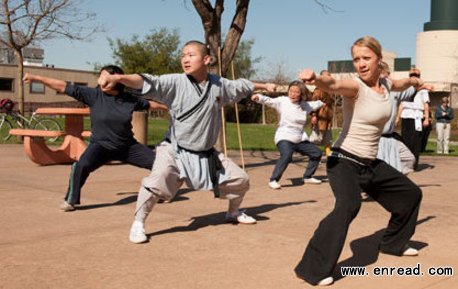由2011年冬季学期开始,斯坦福大学开设了一门少林功夫课。这门课基本上是一个功夫班,由少林寺和尚执教。

Lisa Becker, a biology research assistant, learns Shaolin Kung Fu from the masters in the class at Stanford.
Master Shi Yanran has performed kung fu all over the world – with the Shaolin Temple Kung Fu
Monks2 Corps3, in the
theatrical4(戏剧性的) extravaganza(娱乐表演,盛典) Shaolin: Wheel of Life, and with contemporary ballet dancers in Long River High Sky.
In 2010, he was named martial5 artist(武术家) of the year at the 12th World Congress on Qigong and Traditional Chinese Medicine, which was held in San Francisco.
Yet here he was, a Buddhist6 monk1 ordained7 at the legendary8 Songshan Shaolin Temple in central China, striding into a Stanford campus courtyard, ready to teach a mind-body fitness class sponsored by the university's Health Improvement Program.
He wore a cinnamon-brown robe with a sparkling name – a "triple jewel robe." It signifies that he has accepted the three gems9 of the spiritual life – the Buddha10, the teachings of Buddha and the monastic(僧尼的) Buddhist community.
Master Yanran was accompanied by six monks, ranging in age from 18 to 27, who wore light blue, belted robes, trimmed in black, bearing the embroidered11 logo of Shaolin Temple USA, which is headquartered in San Francisco. The logo shows the front gate of the Songshan Shaolin Temple, which is revered12 as the birthplace of Chan (Zen) Buddhism13 and as the cradle of Shaolin Kung Fu.
Their students – wearing T-shirts, loose-fitting pants and athletic14 shoes – soon converged15(聚集) on the courtyard for the weekly hour-long class, which takes place in a courtyard behind the Medical School Office Building on Welch Road.
Paula Bailey, an education coordinator16 at the Center for Biomedical Ethics17, arrived with a straight sword, its blade resting safely inside a garnet-red scabbard.
Paochen Zhang, an administrative18 associate in the research lab at Stanford Blood Center, carried a slender wooden staff grasped firmly in one hand.
Kathleen Guan, an administrative associate in the Department of Structural19 Biology, brought no weapons – only her novice20 self, eager to learn. Guan, who was born in Beijing and came to the United States 30 years ago, said the class represented a rare opportunity to study with Shaolin monks.
"The monks are surprisingly good teachers," Guan said. "They are graceful21, patient and eager to teach us. The big plus is that I'm learning real kung fu from real Shaolin monks, whom I would have no access to if I were still in China – all under the California sun."
They were among the 17 students – 12 women and five men – who attended a recent class. Currently, 22 people are enrolled22 in the class.
Master Yanran, who began his studies at the Songshan Shaolin Temple when he was 9 years old, recently celebrated23 his 30th birthday.
The monks began teaching Shaolin Kung Fu: Beginner, Intermediate & Advanced at Stanford during winter quarter of 2011.
"Participants will achieve harmony of body and mind through a well-balanced program, appropriate for people of all ages and physical abilities who seek to create better health and well-being24, train for self-defense, and improve strength and flexibility," the class description said. "No prior martial arts experience necessary."
The class, which costs $100, is offered at a discount rate of $20 to Stanford faculty25 and staff who have completed the Stanford Health and Lifestyle Assessment26 (SHALA), an online questionnaire that is part of the BeWell@Stanford Employee Incentive27 Program.
Jerrie Thurman, group fitness program manager with the Health Improvement Program, said a Stanford employee contacted her about bringing the Shaolin Monks to campus. After reviewing Shaolin Temple USA, its curriculum and instructors28, Thurman said she decided29 to offer the class for one quarter to gauge30(测量,估计) interest in the class.
"I was pleased at the initial response and am happy that the interest continues to be pretty high," she said. "The class is offered every quarter, and will continue to be offered unless interest in the class drops off significantly, or if the instructors become unavailable to teach the class."
Master Yanran said Shaolin Kung Fu is different than other martial arts systems because it incorporates the teachings of Buddhism.
"The spirit of Shaolin Kung Fu includes compassion31, harmony, diligence and inclusiveness," he said, speaking through translator Diana Hong. "It is not a brutal32 fighting system. In addition to self-defense skills, Shaolin Kung Fu exercises also improve the health and overall spirit."

 收听单词发音
收听单词发音 


